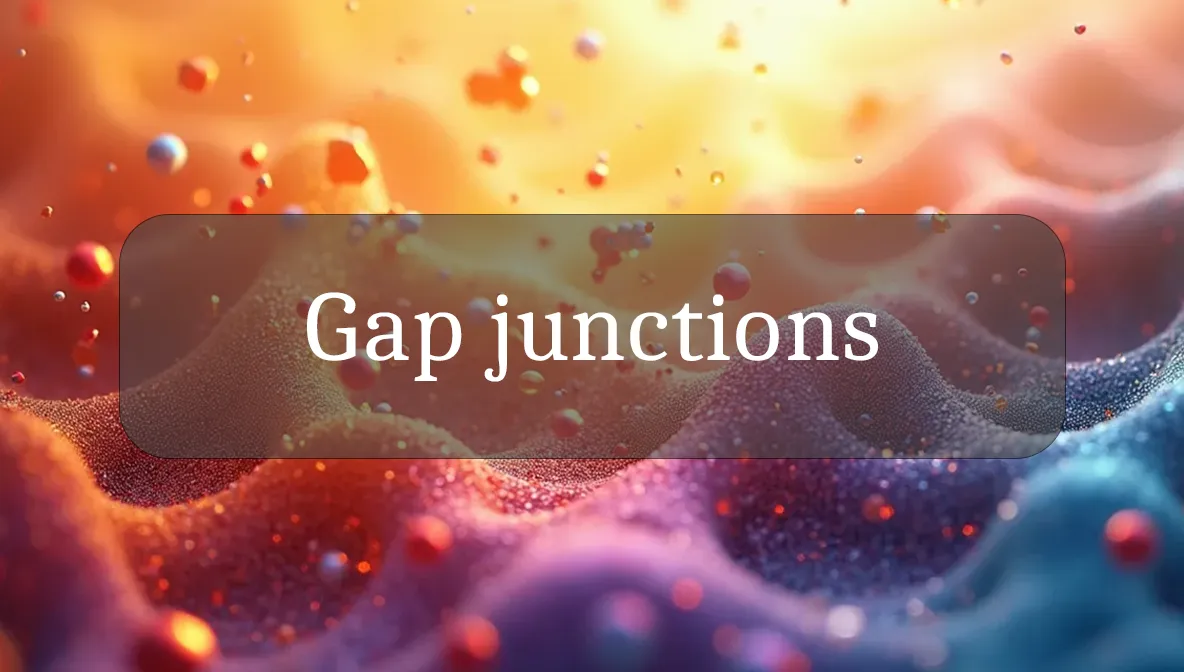Your Cells’ Communication Network
Gap junctions are like tiny tunnels between cells, allowing them to share signals and coordinate like a well-organized team. These microscopic channels are crucial for keeping your heart, muscles, and other tissues working in sync. Let’s explore what gap junctions are, how they support your health, and how to promote their function for daily wellness.
Identity and Function
Gap junctions are specialized protein channels that connect the cytoplasm of neighboring cells, enabling direct communication. Made of proteins called connexins, they form small pores that allow the passage of ions, small molecules (like calcium or glucose), and electrical signals. Found in tissues like the heart, brain, and muscles, their main job is to synchronize cell activities, ensuring tissues function as a unit.
Biological Role and Health Impact
Gap junctions are vital for coordinating your body’s systems:
- Heart Rhythm: In the heart, they transmit electrical signals between muscle cells, ensuring a steady, synchronized heartbeat.
- Nervous System: In the brain and nerves, they help neurons and glial cells share signals, supporting quick responses and brain function.
- Muscle Coordination: In smooth muscles (e.g., intestines, uterus), they sync contractions for digestion or labor.
- Tissue Repair: They allow cells to share nutrients or signals during healing, promoting recovery from injury.
- Metabolic Balance: Gap junctions help cells exchange small molecules, maintaining tissue health and energy balance.
By enabling cell teamwork, gap junctions support your heart health, brain function, and ability to stay active and resilient.
Supporting Health
To keep gap junctions and the tissues they connect healthy:
- Eat Nutrient-Rich Foods: Include antioxidants like vitamin C (berries, peppers) and E (nuts, seeds) to protect connexin proteins from oxidative stress, plus omega-3s (salmon, flaxseeds) for heart and brain health.
- Stay Hydrated: Drink 8–10 cups of water daily to support cell function and maintain proper ion balance for gap junction signaling.
- Exercise Regularly: Activities like jogging or yoga improve circulation, delivering nutrients to tissues where gap junctions operate.
- Avoid Toxins: Limit alcohol, smoking, or exposure to pollutants, which can damage connexins or disrupt cell communication.
- Get Enough Sleep: Aim for 7–9 hours nightly to allow cellular repair, including maintenance of gap junction proteins.
Signs of Dysfunction
Gap junction issues are rare but can lead to health problems, often linked to genetic or environmental factors:
- Heart Problems:
- Irregular heartbeat (arrhythmias) or palpitations, linked to faulty gap junctions in cardiac muscle (e.g., in some cardiomyopathies).
- Neurological Issues:
- Seizures, hearing loss, or developmental delays in rare genetic disorders (e.g., connexin mutations in Charcot-Marie-Tooth disease).
- Skin or Eye Symptoms:
- Skin disorders or cataracts, as seen in some genetic conditions affecting gap junctions (e.g., oculodentodigital dysplasia).
- Delayed Healing:
- Slow wound healing or chronic inflammation, as gap junctions aid tissue repair.
If you notice heart irregularities, neurological symptoms, or persistent healing issues, see a doctor for tests like ECG, genetic screening, or tissue analysis.
Promoting Optimal Function
To support gap junctions and tissue communication:
- Balance Your Diet: Ensure adequate protein (1.2–2g per kg body weight daily) for connexin synthesis, plus zinc (oysters, chickpeas) and magnesium (spinach, almonds) for cell signaling.
- Manage Stress: Chronic stress can disrupt cell communication via cortisol, so try meditation, deep breathing, or hobbies to stay relaxed.
- Monitor Heart Health: Regular checkups with blood pressure and ECG tests help catch issues affecting cardiac gap junctions early.
- Limit Inflammation: Eat anti-inflammatory foods (leafy greens, turmeric) to reduce stress on gap junctions in tissues like the heart or brain.
- Stay Active: Exercise enhances gap junction function in the heart and muscles by improving blood flow and reducing oxidative damage.
Safety and Stressors
Gap junctions are naturally robust, but certain factors can affect them:
- Medical Conditions: Genetic disorders (e.g., connexin mutations) or diseases like diabetes or heart failure can impair gap junction function, requiring medical management.
- Medications: Some drugs (e.g., certain anesthetics or anti-arrhythmics) may affect gap junctions. Use as prescribed and discuss side effects with your doctor.
- Environmental Toxins: Exposure to heavy metals, pesticides, or chronic alcohol can damage connexins. Minimize exposure where possible.
- Infections or Inflammation: Chronic inflammation from infections or autoimmune diseases can disrupt gap junction signaling. Treat underlying conditions promptly.
If you suspect gap junction-related issues or have chronic heart, neurological, or healing symptoms, consult a cardiologist, neurologist, or specialist for targeted care.
Fun Fact
Did you know gap junctions are like cellular Wi-Fi? They let heart cells “talk” so fast that a single electrical signal can spread across your entire heart in less than a second, keeping your heartbeat perfectly timed!
Citations
- National Institutes of Health (NIH): Gap Junctions and Cell Communication.
- Mayo Clinic: Arrhythmias and Heart Function.
- Cleveland Clinic: Understanding Cellular Structures.
- American Heart Association: Cardiac Cell Communication.
- Journal of Cell Science: Gap Junction Function and Health (2021).

